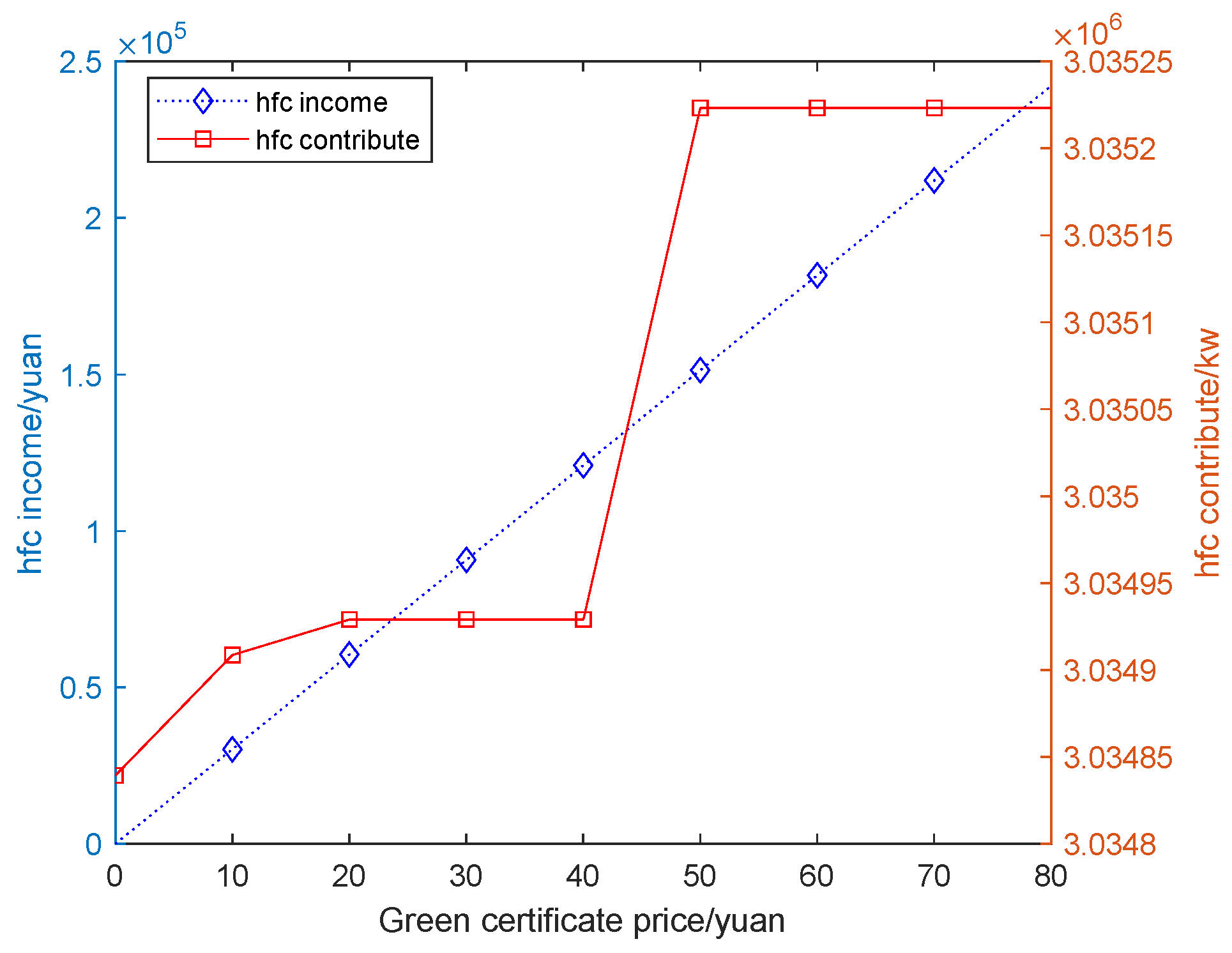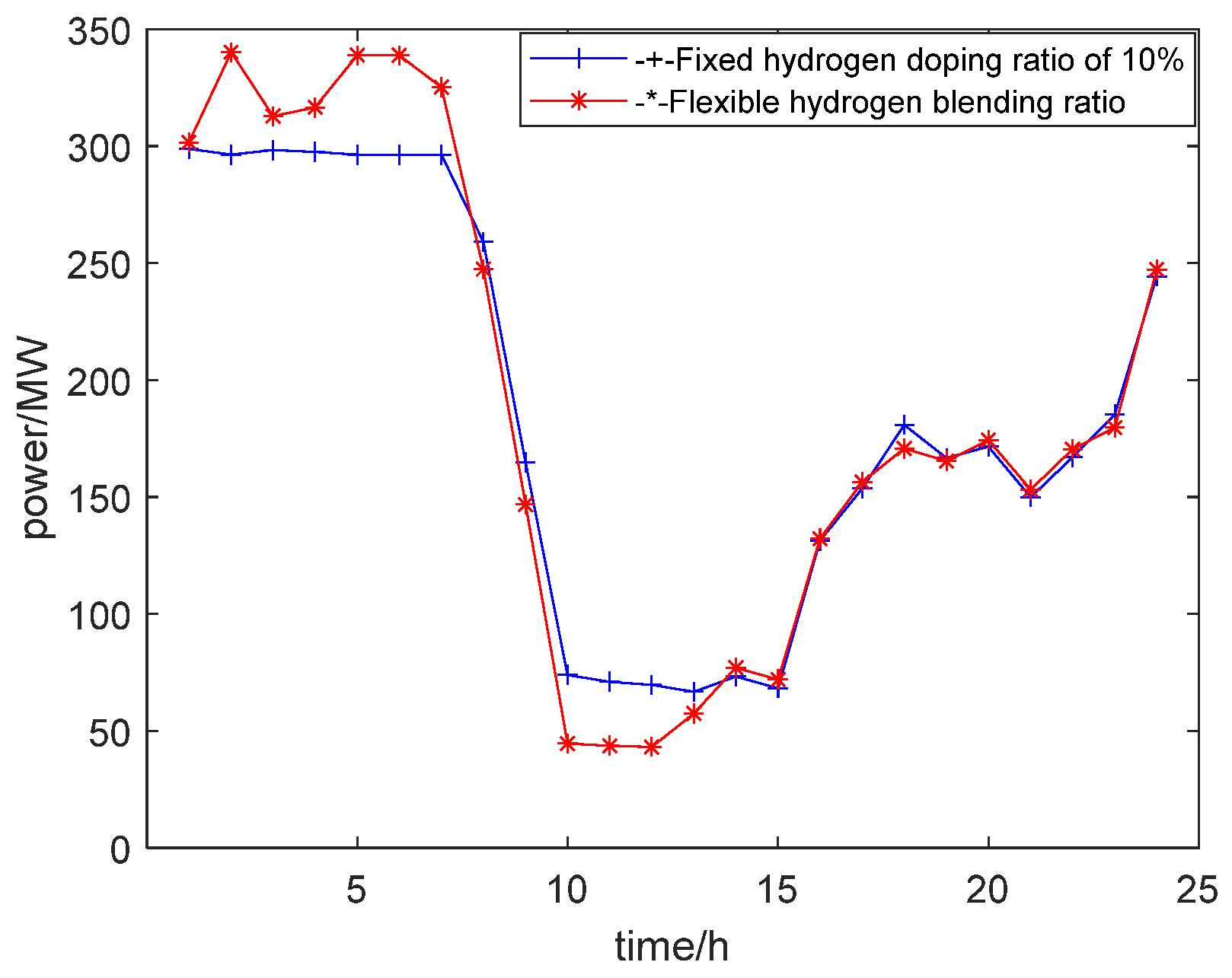Optimal Scheduling of Integrated Energy System Considering Hydrogen Blending Gas and Demand Response
Abstract
:1. Introduction
- In order to achieve a large-scale grid connection of new energy, a comprehensive energy optimization dispatching system is built with gas hydrogen generation technology as the core, and the absorption capacity of renewable energy is improved.
- Under the premise of considering the economic benefits of the system, the optimization of the output of the system equipment is achieved in full combination with China’s energy policy.
- In the integrated energy system, the influence of the change in the hydrogen incorporation ratio on the equipment output and economy of the system is analyzed, and the economy of the system operation is further improved.
2. Materials and Methods
2.1. Considering the IES Structure Block Diagram Containing Hydrogen
2.2. Mathematical Model of Hydrogen Energy Comprehensive Production and Utilization Unit
2.2.1. Green Hydrogen Production Link
2.2.2. Hydrogen Heating Process
2.2.3. Hydrogen Mixing Link of Gas Network
2.2.4. HCNG Heating Process
2.3. IES System Economic Optimization Model
2.3.1. Objective Function
2.3.2. Construction of the System Operation Model
2.3.3. Solution of the Linearized Model
3. Results
3.1. Economic Analysis of System Operation
- Scenario 1 is the traditional integrated energy system that does not consider the electrolytic equipment and hydrogen fuel cells;
- Scenario 2 is a comprehensive energy system that considers hydrogen energy utilization and considers a fixed value of hydrogen mixing ratio of 10%;
- Scenario 3 is an integrated energy system that considers the utilization of hydrogen energy, and the hydrogen mixing ratio of the pipeline network is considered to vary between 2 and 20%.
3.1.1. Analysis of System Wind Absorption
3.1.2. Analysis of System Carbon Emission
3.2. Analysis of the Influence of Green Certificate Price on the Output of Hydrogen Equipment
3.3. Analysis of the Influence of Hydrogen Mixing Ratio on the System
3.4. Analysis of User Energy Optimization Scheduling Results
- Scenario 4, the user unit does not consider demand response;
- Scenario 5, the user unit considers demand response.
4. Discussion
5. Conclusions
- Hydrogen production equipment is added to the system to optimize the peak and trough periods of the system load through demand response. In the low period of system power load, wind power hydrogen production is used to improve the system wind power consumption capacity, so that the system wind power consumption capacity is increased to more than 95%.
- The electric–hydrogen coupling unit in the system partially replaces and assumes the functions of thermal power units and natural gas sources for power supply and heating using technical means such as electrolytic hydrogen production, hydrogen fuel cell power generation, and hydrogen blending, reducing the carbon emissions of the system and improving the flexibility and economy of the system.
- Compared with the traditional electric integrated energy system, hydrogen storage equipment, and hydrogen equipment, the operation cost is very high. However, combined with the green certificate policy, the optimized model described in this paper has significant advantages in improving the system’s wind power consumption capacity and reducing the system’s carbon emissions.
Author Contributions
Funding
Data Availability Statement
Conflicts of Interest
Abbreviations
| T,t | Time state change collection |
| Pt | Battery change state set |
| Qt | Collection of gas energy state changes |
| Ht | Collection of thermal energy state changes |
| GD | Purchase electricity from the grid |
| C | Collection of states of economic change |
| Nc, Nd | Energy storage and release of system energy storage equipment |
| GT | Gas turbine |
| FD | Store and discharge electricity |
| CD | Charge amount of storage device |
| GD | The system buys power from the grid |
| RC | Heat storage devices store energy |
| RF | The heat storage device releases energy |
| QC | Hydrogen storage devices store energy |
| QF | Hydrogen storage devices release energy |
| EL | Electrolytic device power consumption |
| HFC | Hydrogen fuel cell |
| WP | Wind power generation |
| DFH | Electric load |
| RFH | Heat load |
| SRQW | Hydrogen power input to the gas grid |
Appendix A
| Equipment | Argument | Numerical Value |
|---|---|---|
| EL | Maximum/minimum power consumption (MW) | 400/0 |
| Unit climbing rate (MW/h) | 100 | |
| HFC | Maximum and minimum output (MW) | 350/0 |
| Unit climbing rate (MW/h) | 100 | |
| Power generation and heat efficiency | 85%/75% | |
| GT | Maximum and minimum output (MW) | 350/0 |
| Unit climbing rate (MW/h) | 50 | |
| Power generation and heat efficiency | 35%/40% | |
| Stored energy | Upper and lower limits of storage capacity (MW) | 500/50 |
| Maximum charge and discharge power (MW) | 100 | |
| Charge and discharge efficiency | 90% | |
| Initial capacity (MW) | 50 |
| Time Frame | Electricity Price/[CNY/KW·h] |
|---|---|
| 0:00–7:00 | 0.35 |
| 8:00–9:00, 13:00–19:00, 23:00–24:00 | 0.68 |
| 10:00–12:00, 20:00–22:00 | 1.09 |
| Time Frame | Electricity Price/[CNY/m3] |
|---|---|
| 0:00–1:00, 9:00–12:00, 20:00–24:00 | 3.25 |
| 2:00–8:00, 18:00–19:00 | 3.65 |
| 13:00–17:00 | 2.65 |

| Time | 1 | 2 | 3 | 4 | 5 | 6 | 7 | 8 | 9 | 10 | 11 | 12 | |
|---|---|---|---|---|---|---|---|---|---|---|---|---|---|
| Type of Load | |||||||||||||
| Electric load | 205 | 205 | 210 | 195 | 180 | 190 | 190 | 200 | 255 | 345 | 375 | 380 | |
| Heat load | 300 | 325 | 340 | 350 | 370 | 365 | 365 | 340 | 315 | 300 | 280 | 270 | |
| Time | 13 | 14 | 15 | 16 | 17 | 18 | 19 | 20 | 21 | 22 | 23 | 24 | |
| Type of Load | |||||||||||||
| Electric load | 375 | 355 | 350 | 345 | 360 | 360 | 357 | 365 | 365 | 355 | 355 | 310 | |
| Heat load | 250 | 245 | 245 | 245 | 245 | 250 | 252 | 260 | 270 | 290 | 295 | 310 | |
References
- Huang, L. Analysis and control strategy of low-carbon transformation of next-generation power system under the goal of carbon neutrality. Mod. Ind. Econ. Informatiz 2023, 13, 181–183. [Google Scholar]
- Feng, Y.; Xu, Y.; Zhang, J. Application status and prospect of integrated energy system planning and design platform. Energy Conserv. Environ. Prot. 2021, 12, 41–43. [Google Scholar]
- Xue, D. Application prospect of “green hydrogen” in integrated energy system. Contemp. Chem. Ind. Res. 2022, 4, 60–62. [Google Scholar]
- Sun, Y.; Hu, Z.; Qin, A.; Teng, F. Analysis of strategy and technology situation on global hydrogen industry. World Sci. Tech. R D 2020, 42, 455–465. [Google Scholar]
- Xiong, J.; Jiao, Y.; Wang, M. Optimal scheduling of regional integrated energy system considering power-to-gas. Mod. Electr. Power 2022, 39, 554–561. [Google Scholar]
- Zhang, C.; Bai, S.; Zhao, G. Multi-objective Optimal Scheduling of Combined Cooling, Heating and Power Microgrid with Electricity-to-Gas. Jilin Electr. Power 2021, 49, 28–32. [Google Scholar]
- Zhou, B.; Hua, W.; Zhang, Y. P2G Plant and Station Optimization Planning for Electricity-Gas Coupling and Low Carbon. J. Electr. Power Syst. Autom. 2022, 34, 9–17+24. [Google Scholar]
- Gao, Y.; Yuan, C.; Kong, F. Optimization of Integrated Energy System Coupled with Electric-to-Gas and Carbon Capture Equipment under Demand Response Excitation. China Electr. Power 2023, 1–9. [Google Scholar]
- Chen, Y.; Liu, D.; Gao, F. Optimal scheduling of regional integrated energy system considering the refined utilization of hydrogen energy in the power-to-gas link. Power Supply 2021, 38, 59–67. [Google Scholar]
- Deng, Y.; Li, C.; Shao, C. Stochastic Optimal Scheduling of Electric, Heat, Gas and Hydrogen Integrated Energy System. Acta Sol. 2023, 44, 522–529. [Google Scholar]
- Ding, T.; Jia, W.; Huang, Y. Collaborative Optimization of Hydrogen Production, Storage, and Transportation in Mobile Hydrogen Energy System Based on Distributed Robust Opportunistic Constraints. Power Syst. Autom. 2023, 47, 1–11. [Google Scholar]
- Wu, X.; Tan, L.; Zheng, Y. Economic Prospect of Hydrogen and Economic Analysis of Water Electrolysis Technology for Hydrogen Production. Chem. Ind. Eng. 2023, 41, 131–140. [Google Scholar] [CrossRef]
- Wang, X. Development Trends of Hydrogen-Mixed Natural Gas and HCNG. Nat. Gas Chem. Ind. 2018, 43, 23. [Google Scholar]
- Wang, K.; Liang, Y.; Jia, R. Two-stage Optimal Scheduling of Multi-microgrid for Integrated Energy with Hydrogen-doped Gas Based on Nash Negotiation in Uncertain Environment. Power Syst. Technol. 2023, 47, 3141–3159. [Google Scholar]
- Cui, Y.; Shen, Z.; Wang, Z. Green Dispatch of Regional Integrated Energy System Considering the Interaction Mechanism of Green Certificate-Carbon Emission Equivalence. Proc. CSEE 2023, 43, 4508–4517. [Google Scholar]
- Fan, H.; Yang, Z.; Xia, S. Low-carbon economic operation of hydrogen-blended natural gas integrated energy system considering stepped carbon trading mechanism. J. Shanghai Jiao Tong Univ. 2023, 1–21. [Google Scholar] [CrossRef]
- Liang, Y.; Wang, Y.; Liu, H.; Wang, P.; Jing, Y.; Li, J. Optimal Operation of Integrated Energy System Considering Demand Response. J. Phys. Conf. Ser. 2021, 2087. [Google Scholar] [CrossRef]
- Isaac, T. HyDeploy: The UK’s first hydrogen blending deployment project. Clean Energy 2019, 3, 114–125. [Google Scholar] [CrossRef]
- Hydrogen Blending Ratio Reaches 24%! China Has Made a Breakthrough in This Technology! [EB/OL]. Available online: https://tv.cctv.com/2023/04/16/VIDEp897LRcopua0f57onRXI230416.shtml (accessed on 22 August 2023).







| Argument | Scenario 1 | Scenario 2 | Scenario 3 |
|---|---|---|---|
| Utilization rate of wind power/% | 77.42 | 95.10 | 97.15 |
| Cost of purchasing power/CNY 10,000 | 589.80 | 413.81 | 396.13 |
| Carbon emission cost/CNY 10,000 | 143.74 | 140.93 | 131.50 |
| Curtailment cost/CNY 10,000 | 104.43 | 13.67 | 7.95 |
| Running cost/CNY 10,000 | 20.52 | 52.30 | 53.67 |
| Total cost/CNY 10,000 | 858.50 | 620.73 | 589.25 |
Disclaimer/Publisher’s Note: The statements, opinions and data contained in all publications are solely those of the individual author(s) and contributor(s) and not of MDPI and/or the editor(s). MDPI and/or the editor(s) disclaim responsibility for any injury to people or property resulting from any ideas, methods, instructions or products referred to in the content. |
© 2024 by the authors. Licensee MDPI, Basel, Switzerland. This article is an open access article distributed under the terms and conditions of the Creative Commons Attribution (CC BY) license (https://creativecommons.org/licenses/by/4.0/).
Share and Cite
Zheng, Z.; Xiwang, A.; Sun, Y. Optimal Scheduling of Integrated Energy System Considering Hydrogen Blending Gas and Demand Response. Energies 2024, 17, 1902. https://doi.org/10.3390/en17081902
Zheng Z, Xiwang A, Sun Y. Optimal Scheduling of Integrated Energy System Considering Hydrogen Blending Gas and Demand Response. Energies. 2024; 17(8):1902. https://doi.org/10.3390/en17081902
Chicago/Turabian StyleZheng, Zijie, Abuduwayiti Xiwang, and Yufeng Sun. 2024. "Optimal Scheduling of Integrated Energy System Considering Hydrogen Blending Gas and Demand Response" Energies 17, no. 8: 1902. https://doi.org/10.3390/en17081902




